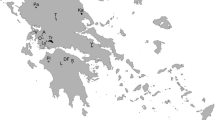Abstract
Numerical classification methods can simulate strategies of intuitive classifications. This paper considers two different intuitive syntaxonomic schemes suggested for stagnant eutrophic fresh-water communities with a view to identifying which among the commonest numerical methods of classification fits the two intuitive schemes best. Comparison of classifications using an information function and discriminant analysis revealed that the different numerical methods simulate different intuitive schemes, but the results of the numerical classifications are always judged superior. Two new syntaxonomic schemes optimizing the sharpness between the syntaxa are proposed.
Similar content being viewed by others
References
Anderberg, M. R., 1973. Cluster analysis for applications, Academic Press, New York & London.
Avena, G., Blasi, C., Feoli, E. & Scoppola, A., 1981. Measurement of the predictive value of species list for species cover in phytosociological samples. Vegetatio 45: 77–84.
Braun-Blanquet, J. & Tüxen, R., 1943. Übersicht der höheren Vegetationseinheiten Mitteleuropas (unter Ausschluss der Hochgebirge), Comm. SIGMA 84.
Den, Hartog, C. & Segal, S., 1964. A new classification of the waterplant communities. Acta Bot. Neerl. 13: 367–393.
Feoli, E. & Lagonegro, M., 1979. Intersection analysis in phytosoclology: computer program and applications. Vegetatio 40: 55–59.
Feoli, E. & Lausi, D., 1980. Hierarehlcal levels in syntaxopomy based on information functions. Vegetatio 42: 113–115.
Feoli, E., Biondani, E. & Lagonegro, M., 1980. Detection of coenoclines in indirect gradient analysis (Italian with English summary). I. Italian Ecological Congress, Salsomaggiore 21–24 Oct. 1980 (in press).
Gerdol, R., Piccoli, F. & Bassi, M., 1979. Contributo alla conoscenza floristica e vegetazionale degli ambienti umidi del Ferrarese: I maceri. Ann. Univ. Ferrara, n.s. sez. Biologia 2: 1–34.
Klecka, W. R., 1975. Discriminant analysis. In: H., Nie et al., (eds.): Statistical package for social seiences (SPSS). Me Graw-Hill, New York: 434–467.
Lohmeyer, W., 1962. Contribution à l'unification du système phytosociologique pour l'Europe moyenne et nord-occidentale. Melhoramento 15: 137–151.
Maarel, E. van der, 1979a. Multivariate methods in Phytosociology with reference to the Netherlands. In: M. J. A. Werger (ed.). The study of vegetation. Junk.
Maarel, E.van der, 1979b. Transformation of cover-abundance values in phytosociology and its effects on community similarity. Vegetatio 39: 97–144.
Oberdorfer, E., 1957. Süddeutsche Pflanzengesellschaften. 1nd ed. Fischer, Jena.
Oberdorfer, E., 1977. Süddeutsche Pflanzengesellschaften, 2nd ed. Bd. 1. Fischer, Stuttgart.
Orlóci, L., 1966. Geometric models in ecology: I. The theory and application of some ordination methods. J. Ecol. 54: 193–215.
Orlóci, L., 1967. An agglomerative method for classification of plant communities. J. Ecol. 55: 193–206.
Orlóci, L., 1978. Multivariate analysis in vegetation research. 2nd ed. Junk, The Hague.
Orlóci, L. & Mukkatu, M. M., 1973. The effect of species number and type of data on the resemblance structure of a phytosociological collection. J. Ecol. 61: 37–46.
Sneath, P. H. A. & Sokal, R. R., 1973. Numerical taxonomy. The principles and practice of numerical classification. Freeman, St. Francisco.
Strahler, A. H., 1977. Response of woody species to site factors in Maryland, USA: Evaluation of sampling plans and of continuous and binary measurement techniques. Vegetatio 35: 1–19.
Strahler, A. H., 1978. Binary discriminant analysis: a new method for investigating species-environment relationships. Ecology 50: 108–116.
Westhoff, V. & Maarel, E.van der, 1978. The Braun-Blanquet approach. 2nd ed. In: R. H., Whittaker (ed.): Classification of plant communities, p. 287–399. Junk, The Hague.
Wiegleb, G., 1978. Der soziologisehe Konnex der 47 häufigsten Gefässmakrophyten Mitteleuropas. Vegetatio 38: 165–174.
Wiegleb, G., 1980. Some applications of principal component analysis in vegetation: Ecological research of aquatic communities. Vegetatio 42: 67–73.
Williams, W. T. & Dale, M. B., 1962. Partition correlation matrices for heterogeneous quantitative data. Nature (London) 196: 602.
Author information
Authors and Affiliations
Additional information
The authors are very grateful to Prof. E. van der Maarel and to Prof. L. Orlóci for reading and correcting the manuscript.
Rights and permissions
About this article
Cite this article
Feoli, E., Gerdol, R. Evaluation of syntaxonomic schemes of aquatic plant communities by cluster analysis. Vegetatio 49, 21–27 (1982). https://doi.org/10.1007/BF00051559
Accepted:
Issue Date:
DOI: https://doi.org/10.1007/BF00051559




